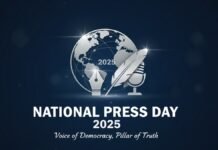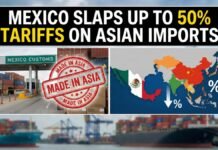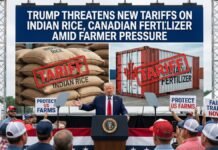
Key Points:
- US imposes extra 25% tariff on Indian goods, effective 27 August 2025 (12:01 am EST).
- New duties lift the total tariff to 50%, equal to Brazil’s, among the highest globally.
- Reason cited: India buying Russian oil, allegedly funding Moscow’s Ukraine war.
- Impact: Indian exports worth $87 billion to the US (2.5% of GDP) affected, particularly textiles, gems, jewellery, chemicals, auto parts.
- Exemptions: Pharmaceuticals, semiconductors, and energy resources spared.
- India’s response: Calls tariffs “unfair and unjust”, rules out immediate retaliation.
- PM Modi’s stance: “India will stand firm, protect farmers, traders and fishermen.”
New Delhi: The US administration on Monday evening formally announced that an additional 25% tariff will be imposed on imports from India starting 27 August 2025 at 12:01 am EST.
This new duty comes on top of an existing 25% reciprocal tariff that has been in effect since 1 August 2025. With this, total tariffs reach 50% on Indian goods entering the US market a drastic escalation in economic confrontation.
The US says the decision was taken due to India’s continued purchase of crude oil from Russia, which Washington claims is indirectly helping Moscow fund the war in Ukraine.
Which Indian Sectors Will Be Hit the Hardest?
While critical sectors including pharmaceuticals, semiconductors, and energy resources have been temporarily exempted, the brunt of the tariffs will fall on traditional export areas.
- Textiles & Apparel
- Gems & Jewellery
- Leather Industry
- Marine Products
- Chemicals & Fertilizers
- Auto Parts
India exported goods worth $87 billion to the US in 2024–25, accounting for nearly 2.5% of India’s GDP. Experts warn these tariffs could squeeze margins for small traders and manufacturers, weakening India’s export competitiveness in the American market.
India Calls US Move “Unfair and Unjust”
In a strong statement, India’s Ministry of External Affairs (MEA) slammed Washington’s decision, describing it as “unfair, unjust, and contrary to the spirit of partnership”.
The MEA defended India’s Russian oil imports, pointing out that:
- They were driven by domestic energy needs and national security concerns.
- Even the US earlier acknowledged India’s role in ensuring global energy market stability, especially during the Ukraine war’s peak years.
Instead of rushing into retaliatory tariffs, New Delhi is reportedly exploring diplomatic channels and incentive schemes to shield exporters from the heavy impact.
Modi’s Defiant Response: “India Will Not Bend”
Addressing a massive rally in Ahmedabad, Gujarat, Prime Minister Narendra Modi took a defiant tone on Monday against Washington’s economic move.
“No matter how much the pressure increases, India will stand firmly. Gujarat has given new energy to the Atmanirbhar Bharat Abhiyan, built on 20 years of hard work,” Modi said.
He assured citizens that:
- Farmers, fishermen, cattle rearers, and small traders will not be left vulnerable.
- The government will act as a shield against foreign economic pressure.
- India will continue to prioritize public interest over global political pressure.
What Next? Growing Uncertainty in Global Trade
The US-India tariff dispute comes at a sensitive time for the global economy, already under strain from:
- The prolonged Russia-Ukraine war.
- US-China trade tensions.
- Global supply chain disruptions and inflation trends.
Analysts say the US decision may force India to diversify export markets further while strengthening self-reliance initiatives under the Atmanirbhar Bharat vision.
Meanwhile, opposition leaders in India have urged the government to protect exporters, while US lawmakers are divided—some supporting Trump’s hardline stance, while others warn that the tariffs could backfire on American consumers through higher retail prices.


















































